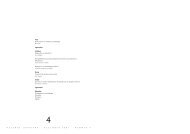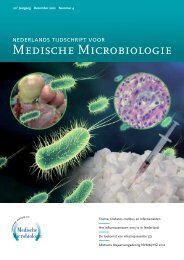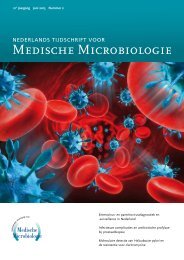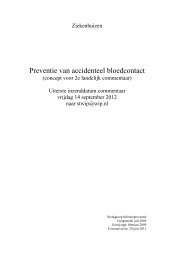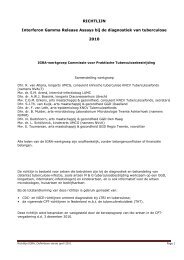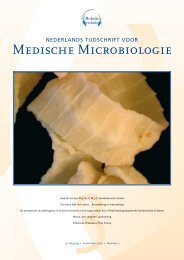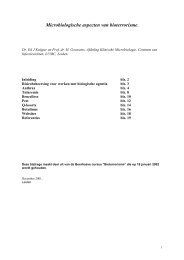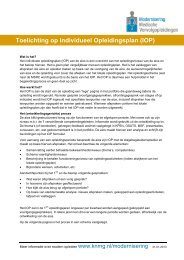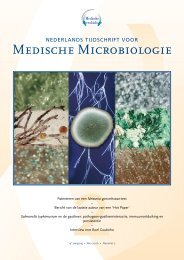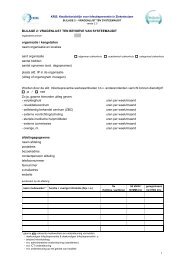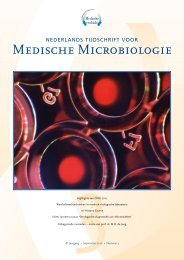S1 De voorjaarsbijeenkomst van de Nederlandse ... - NVMM
S1 De voorjaarsbijeenkomst van de Nederlandse ... - NVMM
S1 De voorjaarsbijeenkomst van de Nederlandse ... - NVMM
Create successful ePaper yourself
Turn your PDF publications into a flip-book with our unique Google optimized e-Paper software.
Where differences occurred these were single category<br />
disagreements (i.e. never a mismatch of S against R).<br />
Testing clinical isolates of Trichophyton spp. was possible<br />
within 16 hr.<br />
The method is simple, low cost and versatile and can be<br />
adapted to new species and antimicrobials. Additionally,<br />
the potential for PAO to be microengineered 2 suggests<br />
further applications in clinical microbiology can be<br />
<strong>de</strong>veloped.<br />
References<br />
1. Ingham CJ, En<strong>de</strong> M <strong>van</strong> <strong>de</strong>n, Wever PC, Schneeberger<br />
PM. J Med Microbiol 2006;55:1511-9.<br />
2. Ingham CJ, Sprenkels A, Bomer J, Molenaar D, Berg A<br />
<strong>van</strong> <strong>de</strong>n, Hylckama Vlieg JET <strong>van</strong>, et al. Proc Natl Acad<br />
Sci USA 2006;46:18217-22.<br />
O077<br />
The use of chromogenic media in medical mycology<br />
I.M. Curfs-Breuker, J.F.G.M. Meis<br />
<strong>De</strong>pt. of Medical Microbiology, Canisius Wilhelmina Hospital,<br />
Nijmegen<br />
Purpose: Because of rising inci<strong>de</strong>nce of candidiasis, the<br />
high morbidity and mortality in immunosuppressed<br />
patients with systemic fungal infections and the variation<br />
in antifungal susceptibility of non-Candida albicans<br />
species, the need for rapid differentiation and i<strong>de</strong>ntification<br />
of yeasts in mixed cultures is <strong>de</strong>sirable. Several<br />
chromogenic media have been <strong>de</strong>veloped; on these media<br />
the yeast colonies have strongly contrasting colours<br />
produced by reactions of species-specific enzymes with<br />
proprietary chromogenic substrates.<br />
The purpose of this study was to compare CandiSelect 4<br />
(Bio-Rad, CS4) and Chromogenic Candida agar (Oxoid,<br />
CCA) with CHROMagar Candida (ITK Diagnostics B.V.,<br />
CHROM).<br />
Methods: 400 clinical samples (sputa, BAL, swabs of<br />
throat, nose, ear and mouth, mouthwashes) were cultured<br />
on CS4, CCA and CHROM, incubated at 30 o C and daily<br />
examined, according to the manufacturers instructions,<br />
for 7 days. During examination special attention was<br />
paid to clear difference and intensity of the colours and<br />
the capability to suppress the growth of bacterias. For<br />
yeast i<strong>de</strong>ntification the germ tube test and Auxacolor 2 ®<br />
were used. The results of CS4 and CCA were compared<br />
to CHROM.<br />
Results:<br />
Compared to CHROM:<br />
- equal score on CS4 in 354 and on CCA in 350 cases<br />
- lower score on CS4 in 16 and on CCA in 24 cases<br />
- better score on CS4 in 25 cases and on CCA in 21<br />
cases.<br />
Ned Tijdschr Med Microbiol 2008;16:Supplement<br />
S32<br />
Findings on CS4 and CCA:<br />
- colony colours specific for Candida albicans on CS4 and<br />
CCA were i<strong>de</strong>ntified as C. albicans. Of all other colony<br />
colours no strain was i<strong>de</strong>ntified as C. albicans.<br />
- the examination of similar colours is subjective<br />
- poor discrimination between light blue and light blue<br />
with turquoise centre on CS4 after an incubation time<br />
of 5-≥7 days<br />
- sporadic or no growth of resistant gram-negative rods.<br />
Findings on CS4:<br />
- C. albicans colour is the clearest and most discriminating<br />
of all chromogenic media<br />
- making difference between the colours of Candida<br />
tropicalis and Candida krusei is difficult<br />
- the C. tropicalis colour is i<strong>de</strong>ntified as Saccharomyces<br />
cerevisiae in 4% of all cases<br />
- discriminating ability is lost when medium is exposed<br />
to light ≥8 hours.<br />
Findings on CCA:<br />
- the C. tropicalis colour is i<strong>de</strong>ntified as S. cerevisiae in 5%<br />
of all cases<br />
- yellow/beige colonies are difficult to observe<br />
- no large discrimination between green and light blue<br />
colonies on CCA after an incubation time of 5-≥7 days.<br />
Conclusions: CS4 has the wi<strong>de</strong>st differentiating ability and<br />
a discriminating colour for Candida glabrata. On CS4 and<br />
CCA the colours of C. albicans are unique to C. albicans,<br />
blue and green colony colours are undistinguishable after<br />
a long incubation time and the capability to suppress the<br />
growth of bacteria.<br />
O078<br />
Separation of species of Fonsecaea on the basis of genealogical<br />
concordance phylogenetic species recognition (gCPSR)<br />
M.J. Najafza<strong>de</strong>h 1,2,3 , H. Badali1,2 , A.H.G. Gerrits <strong>van</strong> <strong>de</strong>n<br />
En<strong>de</strong>1 , G.S. <strong>de</strong> Hoog1,2 1 2<br />
Fungal Biodiversity Centre, Utrecht, Institute for Biodiversity<br />
and Ecosystem Dynamics, University of Amsterdam; 3<strong>De</strong>pt. of<br />
Mycology, Mashhad University of Medical Sciences, Mashhad,<br />
Iran<br />
A multilocus sequence typing (MLST) system based on<br />
sequence analysis of the ribosomal internal transcribed<br />
spacers (ITS), b-tubulin (BT2) and actin (ACT) regions<br />
was performed in 38 strains morphologically i<strong>de</strong>ntified<br />
as Fonsecaea and originating from clinical and environmental<br />
sources in Central and South America, Africa,<br />
East Asia and Europe. Elongation factor 1-alpha (EF1)<br />
could not be amplified. Based on the sequences of ITS,<br />
strains of Fonsecaea were classified into three major<br />
cla<strong>de</strong>s: a group representing Fonsecaea pedrosoi, a group<br />
representing Fonsecaea monophora, and an intermediate<br />
group. The same grouping was found with ACT and BT2.



